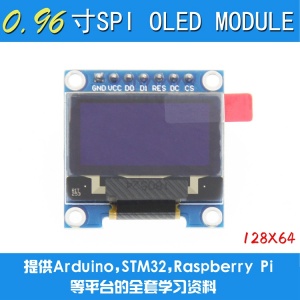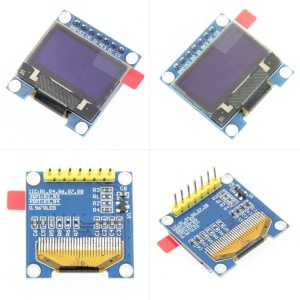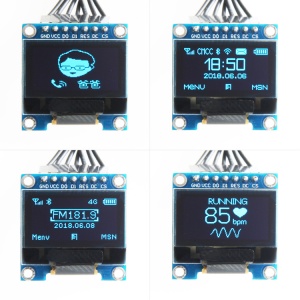Difference between revisions of "0.96inch SPI OLED Module"
(→Product Description) (Tag: Visual edit) |
(→Interface Definition) |
||
| Line 86: | Line 86: | ||
{| class="FCK__ShowTableBorders" align="left" | {| class="FCK__ShowTableBorders" align="left" | ||
|- | |- | ||
| − | ![[file: | + | ![[file:MSP096X-001.png|无框|300px]] |
| − | ![[file: | + | ![[file:MSP096X-002.png|无框|300px]] |
|- | |- | ||
| align="center" | '''Picture 1. Module pin silk screen''' | | align="center" | '''Picture 1. Module pin silk screen''' | ||
| Line 96: | Line 96: | ||
'''NOTE:''' | '''NOTE:''' | ||
| − | :1.This module supports IIC | + | :1.This module supports IIC, 3-wire SPI and 4-wire SPI interface bus mode switching (shown in red box in Figure 2). The details are as follows: |
| − | ::A. | + | ::A.only solder '''R3''' and '''R4''' resistors, then choose '''4-wire SPI''' bus interface ('''default'''); |
| − | ::B. | + | ::B.Only solder '''R2''' and '''R3''' resistors, then select '''3-wire SPI''' bus interface; |
| − | :2. | + | ::C.Only solder '''R1''', '''R4''', '''R6''', '''R7''', '''R8''' resistors, then select the '''IIC''' bus interface; |
| − | :: | + | :2.After the interface bus mode is switched, you need to select the corresponding software and the corresponding wiring pins (as shown in Figure 1) |
| + | ::for the module to operate normally. The corresponding wiring pins are described as follows: | ||
| + | ::A.select the '''4-wire SPI''' bus interface, '''all pins need to be used'''; | ||
| + | ::B.select the '''3-wire SPI''' bus interface, only the '''DC''' pin does not need to be used, other pins need to be used; | ||
| + | ::C.select the '''IIC''' bus interface, only need to use the four pins '''GND''', '''VCC''', '''D0''', '''D1'''; | ||
| + | |||
{| class="wikitable" border="1" style="width: 550px; background-color: white;" | {| class="wikitable" border="1" style="width: 550px; background-color: white;" | ||
Revision as of 10:50, 12 September 2019
Contents
Product Picture
Product Description
- 0.96 inch OLED screen with black and white, black or blue or yellow and blue color display
- 128x64 resolution for clear display and high contrast
- Large viewing angle: greater than 160° (one screen with the largest viewing angle in the display)
- Wide voltage supply (3V~5V), compatible with 3.3V and 5V logic levels, no level shifting chip required
- The default is 4-wire SPI bus, which can choose 3-wire SPI bus or IIC bus
- Ultra-low power consumption: normal display is only 0.06W (far below the TFT display)
- Military-grade process standards, long-term stable work
- Provides a rich sample program for STM32, C51, Arduino, Raspberry Pi and MSP430 platforms
- Provide underlying driver technical support
Product Parameters
| Name | Parameter |
| Display Color | White, blue, yellow and blue |
| SKU | MSP096B
MSP096W MSP096Y |
| Screen Size | 0.96(inch) |
| Screen Type | OLED |
| Driver IC | SSD1306 |
| Resolution | 128*64 (Pixel) |
| Module Interface | 3-line、4-line SPI、IIC interface |
| Active Area | 21.744x10.864 (mm) |
| Touch Screen Type | have no touch screen |
| Touch IC | have no IC |
| Module PCB Size | 27.3x27.8 (mm) |
| Visual Angle | >160° |
| Operating Temperature | -20℃~60℃ |
| Storage Temperature | -30℃~70℃ |
| Operating Voltage | 3.3V~5V |
| Power Consumption | TBD |
| Rough Weight(Package containing) | 8(g) |
Interface Definition
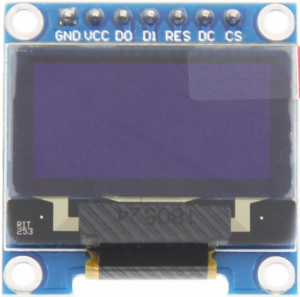
|
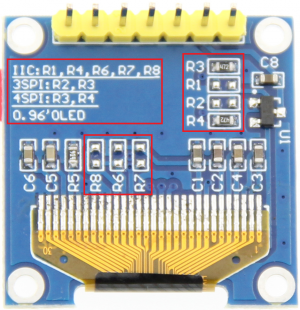
|
|---|---|
| Picture 1. Module pin silk screen | Picture 2. Rear view of the module |
NOTE:
- 1.This module supports IIC, 3-wire SPI and 4-wire SPI interface bus mode switching (shown in red box in Figure 2). The details are as follows:
- A.only solder R3 and R4 resistors, then choose 4-wire SPI bus interface (default);
- B.Only solder R2 and R3 resistors, then select 3-wire SPI bus interface;
- C.Only solder R1, R4, R6, R7, R8 resistors, then select the IIC bus interface;
- 2.After the interface bus mode is switched, you need to select the corresponding software and the corresponding wiring pins (as shown in Figure 1)
- for the module to operate normally. The corresponding wiring pins are described as follows:
- A.select the 4-wire SPI bus interface, all pins need to be used;
- B.select the 3-wire SPI bus interface, only the DC pin does not need to be used, other pins need to be used;
- C.select the IIC bus interface, only need to use the four pins GND, VCC, D0, D1;
| Number | Module Pin | Pin description |
| 1 | VCC | OLED power positive (3.3V~5V) |
| 2 | GND | OLED power ground |
| 3 | SCL | OLED IIC bus clock signal |
| 4 | SDA | OLED IIC bus data signal |
Product Documentation
- 1.3inch IIC_OLED Module User Manual
- 1.3inch OLED Specification
- 1.3inch IIC_OLED Module Size Picture
- 1.3inch IIC_OLED Module Schematic
- 1.3inch IIC_OLED Module OLED Schematic and PCB Package Library
- Driver IC SH1106 Datasheet
Program Download
Reference Materials
- Arduino IDE software use illustration
- RaspberryPi GPIO library installation instructions
- Python Image Library installation instructions
- C51 Keil and stc-isp software use illustration
- STM32 keil software use illustration
- IAR_IDE and MspFet software use illustration
- PCtoLCD2002 software use illustration
- Image2Lcd software use illustration
- Chinese and English display modulo settings
